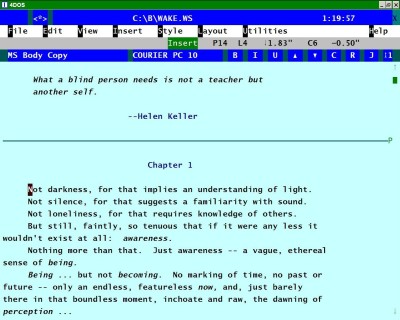25 years of using WordStar; Canadian SF 25 years ago

Twenty-five years ago today, on Friday, December 16, 1983, I started learning the word-processing program WordStar.
I'd bought my first computer, an Osborne 1 CP/M luggable (24 pounds, the most portable computer in the world back then -- see picture below), for the princely sum of Canadian$1,495, in large measure because it came bundled with WordStar, which was then the reigning champ of word-processing programs.
A quarter-century later, I still use WordStar. I started with WordStar for CP/M 2.26, and today use the final release, WordStar for DOS 7.0 Rev. D (the datestamp on the files for that version is 21 December 1992, sixteen years ago now).
WordStar is still, in my humble opinion, the best program ever written for the efficient and creative manipulation of text, for all the reasons I outline here, and I'm not going to switch.
For my very first writing project involving WordStar, I decided to write an article about Canadian achievements in Science Fiction over the past year.
The previous year, I'd worked at Bakka, Toronto's SF specialty bookstore, and, back then, they did an occasional newsletter called The Bakka Bookie Sheet. I choose this project in part because I had become aware that a lot of stuff was starting to happen in Canadian SF, and also because, with all the boldfacing and italics, it would be a good exercise for learning how to format with WordStar.
That article was indeed published in The Bakka Bookie Sheet -- and here it is, a quarter-century after it was written, an intriguing snapshot of what the field was like here all those years ago ...
In September 1983, Bakka Books published an amusing chapbook entitled Toronto's Fantastic Street Names by John Robert Colombo.
Houghton-Mifflin published The Celestial Steam Locomotive, first volume of Michael Coney's "The Song of Earth" trilogy, in November 1983. Coney makes his home in Sidney, B.C.
Charles de Lint of Ottawa is well-known for his excellent semiprozine Dragonfields, of which the fourth number appeared in 1983. But he has also taken the book-publishing world by storm, selling his first, second, and third novels in 1983: The Riddle of the Wren and Moonheart to Ace and The Harp of the Grey Rose to Starblaze.
Augustine Funnel of Lyndhurst, Ontario, wrote "Viewpoint: A Stroll to the Stars" in the August 1983 issue of Isaac Asimov's Science Fiction Magazine [IAsfm].
Another fine collection by Phyllis Gotlieb, Son of the Morning and Other Stories, was released by Ace in December 1983.
Terence M. Green made his first appearance in IAsfm with "Susie Q2" in August 1983. He sold another story to The Magazine of Fantasy and Science Fiction [F&SF]. He reviewed Pauline Gedge's Stargate and Spider Robinson's Mindkiller in the February 1983 Books in Canada. Once again, Terry was an invited reader at the International Conference on the Fantastic in the Arts in Florida.
Collector R. S. Hadji had annotated horror bibliographies in the June, August, and October 1983 issues of Twilight Zone.
Tanya Huff sold script outlines to a TV series in development stage called "Captain Lonestar." Her fantasy story "Claus Clause" was a runner-up in the annual CBC Radio Drama Competition.
David Kesterton, author of The Darkling, and Robert J. Sawyer both joined the Science Fiction Writers of America in 1983, bringing the total Canadian membership of that organization to 18.
Tsunami by Crawford Kilian of Vancouver was published by Douglas & McIntyre.
That brilliant novel Courtship Rite continued to garner honours for Donald Kingsbury. It was a nominee for the Hugo and Locus named it best first novel of the year. Kingsbury was flown to Balticon 17 in April 1983 to accept the Compton N. Crook Memorial Award. Forbidden Planet bookstore announced Don as winner of their first annual Saturn Award in the Best New Writer category.
Toronto doctor Edward Llewellyn's third DAW Books novel, Prelude to Chaos, appeared in February 1983.
Spider Robinson's "Melancholy Elephants" won the Best Short Story Hugo. He signed autographs at Bakka in November 1983.
In June 1983, CBC-TV produced a version of University of Waterloo alumnus Thomas J. Ryan's 1977 novel The Adolescence of P-1. The show, with screenplay by Barrie Wexler, will be broadcast in 1984 as part of the "For the Record" anthology series.
Montrealer Charles R. Saunders sold an Imaro sequel entitled The Quest for Cush to DAW.
Robert J. Sawyer's article on semiprozines was in the Fall 1983 Canadian Author & Bookman. His story "The Contest" was optioned by Bar Harbour films and his script "Earthfall" won an honourable mention in the annual Writer's Digest Writing Competition. His mini-interview with Don Kingsbury appeared in February 1983's Books in Canada and he sold a long Kingsbury interview to Science Fiction Review.
Expatriate Canuck A. E. van Vogt completed a third Null-A book, which so far has only sold in French to a publisher in France. DAW Books published his Computerworld in November 1983.
Andrew Weiner continued his prolific publishing of excellent stories: "One More Time" in the Doubleday anthology Chrysalis 10, "On the Ship" in the May 1983 F&SF, "Takeover Bid" in the June 1983 Twilight Zone, and "Invaders" in the October 1983 IAsfm.
McGill University's Science-Fiction Studies produced issues on "19th-century SF" and "SF in the non-print media." Bill Marks's Vortex had four issues in 1983. A semiprozine called Moonscape appeared, edited by Mogens Brondum of Swan River, Manitoba.
(More such historical notes about Canadian achievements in science fiction are on my website here.)

An Osborne 1 -- Rob's first computer
The Robert J. Sawyer Web Site



6 Comments:
Heh, I used to have one of those. One of the first computers I worked on. I remember learning about programming (albeit in MBasic) playing around with the code for Colossal Cave.
I wish I knew what happened to the thing.
Very impressive that you incorporated those URL hyperlinks in that document even before the WWW was invented ;-)
Hi, Alan. Tim Berners-Lee was a Johnny-come-lately. :) I invented the World Wide Web in 1982 in "Earthfall," the script by me mentioned in the article in this blog entry (although I called it the TerraComp Web). ;)
(The "Earthfall" script was optioned for a while, but never produced; I turned it into a short story and retitled it "Where the Heart Is." It's in the anthology Ark of Ice.)
Do you still have that Osborne?
I've got one like that in my basement but I have no recollection of who passed it on to me.
Yes, I still have my Osborne. Booted it up a few years ago, and it still worked fine. ;)
People used to make fun of the Osborne's 5-inch screen. Now those same people are watching movies on an iPhone's smaller screen. Go figure. :)
Post a Comment
<< Home